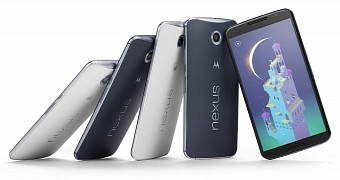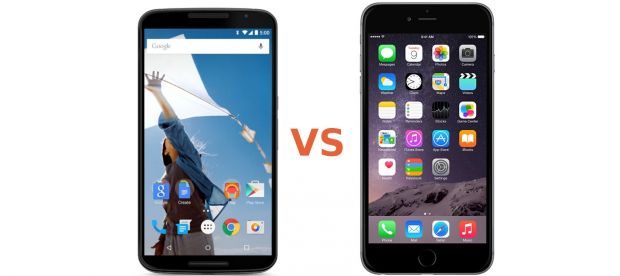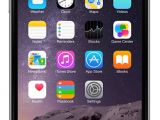After Apple entered the phablet market with its iPhone 6 Plus, Google made a similar move with its Nexus lineup, as the search giant recently announced the Motorola Nexus 6.
If two major companies like Apple and Google decide to launch a phablet as their main product, it must mean something. According to the latest statistics in the market, phablets are now about 25% of the smartphone market worldwide.
Although Apple offers customers two choices (iPhone 6 and iPhone 6 Plus), Google has introduced a single new smartphone this year (Nexus 6), but has kept the one-year old Nexus 5 on sale, so those who aren’t too fond of large displays can get a smaller device.
Apple’s iPhone 6 Plus is already a major success for the Cupertino-based company, but can Google’s Nexus 6 dethrone it as the best-selling phablet this year?
The iPhone 6 Plus already has several weeks ahead of the Nexus 6, so by the time Google’s phablet goes on sale, Apple may have already sold millions of phablets.
Anyway, there’s a certain category of customers who awaited Google to reveal their Nexus handset for this year, so they can better judge if it’s worth getting the Nexus 6 or the iPhone 6 Plus. Even though both devices are phablets, they are different in all aspects.
Nexus 6 is bigger than the iPhone 6 Plus, but not by much
However, having the largest display doesn’t always mean that you’re also the biggest device. Well, the case doesn’t apply here, but Nexus 6 is not far larger than the iPhone 6 Plus, even if it comes with a much larger 6-inch display.
For those who prefer phablets, the Nexus 6 could be the clear winner when it comes to screen. Google’s flagship smartphone packs 6-inch AMOLED capacitive touchscreen display that supports QHD (1440 x 2560 pixels) resolution.
On the other hand, the iPhone 6 Plus has a smaller 5.5-inch Retina IPS LCD display that supports full HD (1080p) resolution.
Of the two phablets, Apple’s smartphone is definitely the thinner one at only 7.1mm, while Nexus 6 is about 10.1mm thin. Motorola Nexus 6 is the bigger of the two at 159.3 x 83mm, whereas Apple’s iPhone 6 Plus measures 158.1 x 77.8mm.
As anyone can notice, the difference is not significant when it comes to size, but the Nexus 6 is definitely much wider than the iPhone 6 Plus.
It’s also worth mentioning that iPhone 6 Plus features shatter proof glass and oleophobic coating, while the Nexus 6 is protected by Corning Gorilla Glass 3.
Hardware-wise, we may already have a winner, and it's not the iPhone
Moving on to the insides of the phablet, things get a bit tricky. Motorola Nexus 6 is equipped with one of the most powerful chipsets available on the market, the Qualcomm Snapdragon 805 SoC. This means that the smartphone is armed with a 2.7GHz quad-core processor, an Adreno 420 graphics processing unit and 3GB of RAM.
The iPhone 6 Plus packs a 1.4GHz dual-core Cyclone processor based on ARMv8 architecture. It also features a quad-core PowerVR GX6450 and only 1GB of RAM.
Apple’s smartphone comes in three variants (16/64/128 GB), while Motorola Nexus 6 will be available in two versions (32/64 GB). Neither of the two comes with microSD card slot for memory expansion.
On the back, the Nexus 6 packs a 13-megapixel photo snapper with OIS (optical image stabilization), dual-LED flash (ring), autofocus and 4K video recording, while the iPhone 6 Plus sports an 8-megapixel camera with OIS, dual-LED (dual tone) flash, autofocus and full HD (1080p) video recording.
While the Nexus lineup of smartphones isn’t known for the high-quality of their cameras, most iPhones do more than decent pictures. It remains to be seen if Motorola made any changes and the Nexus 6 will be a consistent improvement over the previous models.
Connectivity-wise, both smartphones seem to support just about any LTE band out there, but the Nexus 6 comes with support for LTE Cat.6 (300Mbps download / 50Mbps upload) whereas the iPhone 6 Plus has LTE Cat.4 (150Mbps download / 50Mbps upload).
Motorola Nexus 6 is powered by a non-removable 3220 mAh battery, which should provide up to 330 hours of standby time or up to 24 hours of usage, while the iPhone 6 Plus comes with a 2915 mAh battery that’s been rated for 384 hours of standby time and 24 hours of usage.
You must also choose your favorite ecosystem: Android or iOS
It’s also worth mentioning Motorola Nexus 6 is water resistant and features dual front speakers, while the iPhone 6 Plus comes with Apple Pay (via NFC) and packs Touch ID (fingerprint sensor).
Each of these phablets ships with the latest version of Apple’s and Google’s operating systems. The iPhone 6 Plus runs iOS 8, while the Nexus 6 will be delivered with Android 5.0 Lollipop.
Specs aside, when customers choose between the iPhone 6 Plus and Nexus 6, they also choose between two ecosystems, iOS and Android, so it’s up to each and every one which operating system and device better suits their needs.
If you had to choose between the two phablets, which one would you get and why? Share your thoughts with us in the comments section.

 14 DAY TRIAL //
14 DAY TRIAL // 


